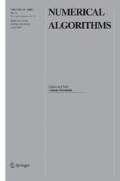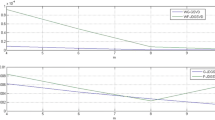Abstract
In this paper, a two-sided, parallel Kogbetliantz-type algorithm for the hyperbolic singular value decomposition (HSVD) of real and complex square matrices is developed, with a single assumption that the input matrix, of order n, admits such a decomposition into the product of a unitary, a non-negative diagonal, and a J-unitary matrix, where J is a given diagonal matrix of positive and negative signs. When J = ±I, the proposed algorithm computes the ordinary SVD. The paper’s most important contribution—a derivation of formulas for the HSVD of 2 × 2 matrices—is presented first, followed by the details of their implementation in floating-point arithmetic. Next, the effects of the hyperbolic transformations on the columns of the iteration matrix are discussed. These effects then guide a redesign of the dynamic pivot ordering, being already a well-established pivot strategy for the ordinary Kogbetliantz algorithm, for the general, n × n HSVD. A heuristic but sound convergence criterion is then proposed, which contributes to high accuracy demonstrated in the numerical testing results. Such a J-Kogbetliantz algorithm as presented here is intrinsically slow, but is nevertheless usable for matrices of small orders.




Similar content being viewed by others
Notes
For a = 0, η(a) = 0 instead of a huge negative integer, so taking \(\max \limits \{|a|,\omega \}\) filters out such a.
For example, the minimumNumber operation of the IEEE 754-2019 standard [12, section 9.6].
References
Anderson, E., Bai, Z., Bischof, C., Blackford, S., Demmel, J., Dongarra, J., Du Croz, J., Greenbaum, A., Hammarling, S., McKenney, A., Sorensen, D.: LAPACK Users’ Guide. Software, Environments and Tools, 3rd edn. Society for Industrial and Applied Mathematics, Philadelphia (1999). https://doi.org/10.1137/1.9780898719604
Baudet, G., Stevenson, D.: Optimal sorting algorithms for parallel computers. IEEE Trans. Comput. C-27(1), 84–87 (1978). https://doi.org/10.1109/TC.1978.1674957
Bečka, M., Okša, G., Vajteršic, M.: Dynamic ordering for a parallel block-Jacobi SVD algorithm. Parallel Comp. 28(2), 243–262 (2002). https://doi.org/10.1016/S0167-8191(01)00138-7
Bojanczyk, A.W., Onn, R., Steinhardt, A.O.: Existence of the hyperbolic singular value decomposition. Linear Algebra Appl. 185(C), 21–30 (1993). https://doi.org/10.1016/0024-3795(93)90202-Y
Charlier, J.P., Vanbegin, M., Van Dooren, P.: On efficient implementations of Kogbetliantz’s algorithm for computing the singular value decomposition. Numer. Math. 52(3), 279–300 (1987). https://doi.org/10.1007/BF01398880
Drmač, Z.: Implementation of Jacobi rotations for accurate singular value computation in floating point arithmetic. SIAM J. Sci. Comput. 18(4), 1200–1222 (1997). https://doi.org/10.1137/S1064827594265095
Hari, V., Matejaš, J.: Accuracy of two SVD algorithms for 2 × 2 triangular matrices. Appl. Math. Comput. 210 (1), 232–257 (2009). https://doi.org/10.1016/j.amc.2008.12.086
Hari, V., Singer, S., Singer, S.: Block-oriented J-Jacobi methods for Hermitian matrices. Linear Algebra Appl. 433(8–10), 1491–1512 (2010). https://doi.org/10.1016/j.laa.2010.06.032
Hari, V., Singer, S., Singer, S.: Full block J-Jacobi method for Hermitian matrices. Linear Algebra Appl. 444, 1–27 (2014). https://doi.org/10.1016/j.laa.2013.11.028
Hari, V., Veselić, K.: On Jacobi methods for singular value decompositions. SIAM J. Sci. Stat. 8(5), 741–754 (1987). https://doi.org/10.1137/0908064
Hari, V., Zadelj-Martić, V.: Parallelizing the Kogbetliantz method: A first attempt. J. Numer. Anal. Ind. Appl. Math. 2(1–2), 49–66 (2007)
IEEE Computer Society: 754-2019 - IEEE Standard for Floating-Point Arithmetic. IEEE, New York. https://doi.org/10.1109/IEEESTD.2019.8766229 (2019)
ISO/IEC JTC1/SC22/WG5: ISO/IEC 1539-1:2018(en) Information Technology — Programming languages — Fortran — Part 1: Base language, 4th edn. ISO, Geneva (2018)
Kogbetliantz, E.G.: Solution of linear equations by diagonalization of coefficients matrix. Quart. Appl. Math. 13(2), 123–132 (1955). https://doi.org/10.1090/qam/88795
Kulikov, G. Yu., Kulikova, M.V.: Hyperbolic-singular-value-decomposition-based square-root accurate continuous-discrete extended-unscented Kalman filters for estimating continuous-time stochastic models with discrete measurements. Int. J. Robust Nonlinear Control 30, 2033–2058 (2020). https://doi.org/10.1002/rnc.4862
Kulikova, M.V.: Hyperbolic SVD-based Kalman filtering for Chandrasekhar recursion. IET Control Theory A. 13(10), 1525–1531 (2019). https://doi.org/10.1049/iet-cta.2018.5864
Kulikova, M.V.: Square-root approach for Chandrasekhar-based maximum correntropy Kalman filtering. IEEE Signal Process Lett. 26(12), 1803–1807 (2019). https://doi.org/10.1109/LSP.2019.2948257
Mackey, D.S., Mackey, N., Tisseur, F.: Structured factorizations in scalar product spaces. SIAM J. Matrix Anal. and Appl. 27(3), 821–850 (2005). https://doi.org/10.1137/040619363
Matejaš, J., Hari, V.: Accuracy of the Kogbetliantz method for scaled diagonally dominant triangular matrices. Appl. Math. Comput. 217(8), 3726–3746 (2010). https://doi.org/10.1016/j.amc.2010.09.020
Matejaš, J., Hari, V.: On high relative accuracy of the Kogbetliantz method. Linear Algebra Appl. 464, 100–129 (2015). https://doi.org/10.1016/j.laa.2014.02.024
Novaković, V.: A hierarchically blocked Jacobi SVD algorithm for single and multiple graphics processing units. SIAM J. Sci. Comput. 37(1), C1–C30 (2015). https://doi.org/10.1137/140952429
Novaković, V.: Batched computation of the singular value decompositions of order two by the AVX-512 vectorization. Parallel Process. Lett. 30(4), 2050015 (2020). https://doi.org/10.1142/S0129626420500152
Novaković, V., Singer, S.: A GPU-based hyperbolic SVD algorithm. BIT 51(4), 1009–1030 (2011). https://doi.org/10.1007/s10543-011-0333-5
NVIDIA Corp.: CUDA C++ Programming Guide v10.2.89. https://docs.nvidia.com/cuda/cuda-c-programming-guide/ (2019)
Okša, G., Yamamoto, Y., Bečka, M., Vajteršic, M.: Asymptotic quadratic convergence of the two-sided serial and parallel block-Jacobi SVD algorithm. SIAM J. Matrix Anal. and Appl. 40(2), 639–671 (2019). https://doi.org/10.1137/18M1222727
Onn, R., Steinhardt, A.O., Bojanczyk, A.W.: The hyperbolic singular value decomposition and applications. IEEE Trans. Signal Process. 39 (7), 1575–1588 (1991). https://doi.org/10.1109/78.134396
OpenMP ARB: OpenMP Application Programming Interface Version 5.0. https://www.openmp.org/wp-content/uploads/OpenMP-API-Specification-5.0.pdf (2018)
Singer, S.: Indefinite QR factorization. BIT 46(1), 141–161 (2006). https://doi.org/10.1007/s10543-006-0044-5
Singer, S., Di Napoli, E., Novaković, V., Čaklović, G.: The LAPW method with eigendecomposition based on the Hari–Zimmermann generalized hyperbolic SVD. SIAM J. Sci. Comput. 42(5), C265–C293 (2020). https://doi.org/10.1137/19M1277813
Singer, S., Singer, S., Novaković, V., Davidović, D., Bokulić, K., Ušćumlić, A.: Three-level parallel J-Jacobi algorithms for Hermitian matrices. Appl. Math. Comput. 218(9), 5704–5725 (2012). https://doi.org/10.1016/j.amc.2011.11.067
Singer, S., Singer, S., Novaković, V., Ušćumlić, A., Dunjko, V.: Novel modifications of parallel Jacobi algorithms. Numer. Algorithms 59(1), 1–27 (2012). https://doi.org/10.1007/s11075-011-9473-6
Slapničar, I.: Accurate symmetric eigenreduction by a Jacobi method. Ph.D. thesis, FernUniversitȧt–Gesamthochschule, Hagen (1992)
Slapničar, I.: Componentwise analysis of direct factorization of real symmetric and Hermitian matrices. Linear Algebra Appl. 272, 227–275 (1998). https://doi.org/10.1016/S0024-3795(97)00334-0
Stewart, G.W.: An updating algorithm for subspace tracking. IEEE Trans. Signal Process. 40(6), 1535–1541 (1992). https://doi.org/10.1109/78.139256
Veselić, K.: A Jacobi eigenreduction algorithm for definite matrix pairs. Numer. Math. 64 (1), 241–269 (1993). https://doi.org/10.1007/BF01388689
Zha, H.: A note on the existence of the hyperbolic singular value decomposition. Linear Algebra Appl. 240, 199–205 (1996). https://doi.org/10.1016/0024-3795(94)00197-9
Acknowledgements
We are much indebted to Saša Singer‡ for his suggestions on the paper’s subject, and to the anonymous referee for significantly improving the presentation of the paper.
Funding
This work has been supported in part by Croatian Science Foundation under the project IP–2014–09–3670 “Matrix Factorizations and Block Diagonalization Algorithms” (https://web.math.pmf.unizg.hr/mfbda/).
Author information
Authors and Affiliations
Corresponding author
Ethics declarations
Conflict of interest
The authors declare no competing interests.
Additional information
Author contribution
The second author formulated the research topic, reviewed the literature, plotted the figures and proofread the manuscript. The first author performed the rest of the research tasks.
Data availability
Several animations and the full testing dataset with the matrix outputs are available at http://euridika.math.hr:1846/Jacobi/JKogb/ or by request.
Code availability
The source code is available in https://github.com/venovako/JKogb repository.
Publisher’s note
Springer Nature remains neutral with regard to jurisdictional claims in published maps and institutional affiliations.
This work is dedicated to the memory of Sanja Singer.
Appendix: . Proofs of Lemmas 3.1 and 3.2
Appendix: . Proofs of Lemmas 3.1 and 3.2
Proof
(Lemma 3.1) Let, for 1 ≤ ℓ ≤ n, \(\gamma _{\ell }=\arg (x_{\ell })\) and \(\delta _{\ell }=\arg (y_{\ell })\). Then,
Using the second equality, from the matrix multiplication it follows
and using the third equality, from the matrix multiplication it follows
Since \(|e^{-\mathrm {i}\gamma _{\ell }^{}}x_{\ell }^{\prime }|=|x_{\ell }^{\prime }|\) and \(|e^{-\mathrm {i}\delta _{\ell }^{}}y_{\ell }^{\prime }|=|y_{\ell }^{\prime }|\) and \(\cos \limits (-\phi )=\cos \limits \phi \), it holds
After grouping the terms, the square of the Frobenius norm of the new ℓ th row is
Summing the left side of (A.1) over all ℓ one obtains
what is equal to the right side of (A.1), summed over all ℓ,
where \(-1\le \zeta _{\ell }^{}=\cos \limits (\delta _{\ell }^{}-\gamma _{\ell }^{}-\beta )\le 1\), so \(|\zeta _{\ell }^{}|\le 1\). The last sum can be split into a non-negative part and the remaining part of an arbitrary sign,
Using the triangle inequality, and observing that \({\sum }_{\ell =1}^{n}(|x_{\ell }^{}|^{2}+|y_{\ell }^{}|^{2})=\left \|\left [\begin {array}{cc}\mathbf {x}&\mathbf {y} \end {array}\right ]\right \|_{F}^{2}\), this value can be bounded above by
and below by
where both bounds can be simplified by the identities
By the inequality of arithmetic and geometric means it holds \(2|x_{\ell }^{}||y_{\ell }^{}|\le (|x_{\ell }^{}|^{2}+|y_{\ell }^{}|^{2})\), so a further upper bound is reached as
and a further lower bound as
what, after grouping the terms and dividing by \(\left \|\left [\begin {array}{cc}\mathbf {x}&\mathbf {y} \end {array}\right ]\right \|_{F}^{2}\), concludes the proof. □
Proof
(Lemma 3.2) Note that \(\cosh (2\psi )+|\sinh (2\psi )|\ge \cosh (2\psi )\ge 1\), and
If ψ = 0, the equalities in the bounds established in Lemma 3.1 hold trivially. Also, if both equalities hold simultaneously, ψ = 0.
The inequality of arithmetic and geometric means in the proof of Lemma 3.1 turns into equality if and only if |xℓ| = |yℓ| for all ℓ. When |xℓ||yℓ|≠ 0, it has to hold ζℓ = ζ, where \(\zeta =\pm \text {sign}(\sinh \psi )\), to reach the upper or the lower bound, respectively. From ζ = ± 1 it follows δℓ = γℓ + β + lπ for a fixed \(l\in \mathbb {Z}\), i.e., \(x_{\ell }=e^{\mathrm {i}\gamma _{\ell }}|x_{\ell }|\) and \(y_{\ell }=\pm e^{\mathrm {i}\beta }e^{\mathrm {i}\gamma _{\ell }}|x_{\ell }|\), so yℓ = ±eiβxℓ for all ℓ. Conversely, y = ±eiβx implies, for all ℓ, that |xℓ| = |yℓ| and ζℓ is a constant ζ = ± 1, so one of the two bounds is reached. □
Rights and permissions
About this article
Cite this article
Novaković, V., Singer, S. A Kogbetliantz-type algorithm for the hyperbolic SVD. Numer Algor 90, 523–561 (2022). https://doi.org/10.1007/s11075-021-01197-4
Received:
Accepted:
Published:
Issue Date:
DOI: https://doi.org/10.1007/s11075-021-01197-4
Keywords
- Hyperbolic singular value decomposition
- Kogbetliantz algorithm
- Hermitian eigenproblem
- OpenMP multicore parallelization




